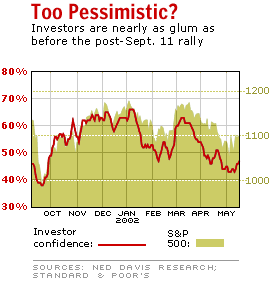
NEW YORK (CNN/Money) -
It was a great week for stocks. The Dow skipped over 400 points higher, the benchmark S&P 500 had its best percentage gain since it bounced off its September lows, and the tech-stuffed Nasdaq put on its biggest rally in over a year.
There will be only one question on traders' minds when they come back to the desk Monday: Is it real?
There are plenty of reasons to worry. The economy may have perked up a bit, but it ain't exactly robust. Enron, and the Securities & Exchange Commission's ever-widening investigation into companies' bookkeeping, has made it hard to take Corporate America at its word. And with the benchmark S&P 500 trading at around 20 times analysts' earnings estimates, you can't exactly argue that stocks are cheap. No wonder so many investors seem so glum these days.
Maybe too glum.

"There is a hell of a lot of skepticism out there," said Seth Tobias, a hedge fund manager with New York-based Circle T. "This is probably the first economic recovery where the investment public are 100 percent nonbelievers, and that's good. It will create opportunities on the buy side."
Yeah, 100 percent is overstating it, but Tobias has got the direction right. Investor sentiment indicators -- investor polls, the ratio of puts (bets against stocks) to calls (bets for them), and so on -- have been painting a dreary picture of the market's mood. In the contrary world of investing, that's good. When sentiment is low, bad news doesn't faze the market as much because investors are pretty much expecting it. Good news, conversely, is always a pleasant surprise.
Ned Davis Research has bundled the different sentiment measures traders look at into an uber-indicator called the Crowd Sentiment Poll. On May 7, when stocks reached a new nadir for the year, it slipped to lows it hadn't seen since the aftermath of Sept. 11. It's only perked up a bit since then.
"We still have quite a bit of pessimism right now," said Ned Davis senior equity strategist Tim Hayes. "That's conducive to further rallying."
Can durable goods help a durable rally
Thursday's durable goods report -- the key bit of economic data for the week -- should help investors figure out if they've been too dour.
Economists reckon that, after falling back in March, durable goods orders rose by 0.4 percent last month, according to Briefing.com. More than that headline number, however, they'll be looking at the guts of the report to see if companies are boosting spending on new equipment, Deutsche Asset Management Americas chief economist Josh Feinman thinks.
In the euphoria of the late 1990s, many U.S. companies bought far more equipment -- particularly in the tech and telecom arena -- than they really needed. The downside was that as the economy faltered and profits dipped they clamped down hard on spending, hurting everyone from Caterpillar to Cisco. Even though he believes the economy is on the mend, Feinman doesn't think spending is going to come back so soon.
"Given how much profits have been beaten up," he said, "I think companies are going to play it close to the vest." Until spending starts to come back, the recovery will be incomplete.
Feinman's view that capital spending isn't ready to pick up yet is pretty much the consensus. But James Padinha, the outspoken economic strategist at Arnhold & S. Bleichroeder, disagrees. -- He thinks the economy is about to bust out all over.
"People are paying too much attention to what companies saying," he said. "Give me a break. They were so bullish for so long they have to be careful. And they have a big incentive to understate it."
Nothing like keeping investor expectations nice and low, and then beating them.
Just because business spending might pick up doesn't mean everybody gets to participate. Nobody overspent like telecommunications companies, and the sector is still a great big mess. According to the Fed's latest report on capacity utilization, communications companies are only running at 54.3 percent of their potential.
Not good news for companies that cater to the sector -- like Ciena (CIEN: Research, Estimates), which is due to report results before the market opens Thursday. The optical equipment company is expected to post a loss of 21 cents a share, according to First Call. Given the capacity overhang among its customers (along with all their other problems -- did somebody say WorldCom?), it could be a while before this company starts making money again.
Home Depot (HD: Research, Estimates), on the other hand, has been making money. Hand over fist. With housing activity bouncing along, the recession didn't deal much of a blow to the do-it-yourself titan -- in fact, its earnings grew over the last year. It reports its second quarter before the markets open on Tuesday, and analysts expect it took in 33 cents a share, up 6 cents from the year-earlier quarter.
Some would say Home Depot's stock price is expensive. It's held up well over the last year, and the company is trading at 37 times last year's earnings -- pretty rich for a retailer. But the other side of that is that most retailers get killed in a recession. Some, like Lechters this time around, even go away. Home Depot's ability to stave off the downturn makes it seem safe. And safe is something that investors are willing to pay up for these days.
Also on deck
Investors looking for more clues on the market have more data and earnings reports to sift through, among them:
- Monday the Conference Board releases its leading indicators index. It usually doesn't move the market, since most of the economic data that make it up have already been released. But it can give you a nice picture of what's going on with the economy. Economists surveyed by Briefing.com think it slipped 0.1 percent in April.
- Also Monday, first-quarter results from Limited (LTD: Research, Estimates) and Toys R Us (TOY: Research, Estimates). Limited's been doing OK lately, but Toys R Us has had a hard time of it. Still, its stock hopped higher earlier this month when it said that its results wouldn't be quite so dismal as investors thought.
- Tuesday the April Treasury budget comes out. Usually of limited interest, this time around it will give some sense of what tax receipts were -- and how much debt the government may have to issue. For bond types, that's important.
- Target (TGT: Research, Estimates) reports first-quarter results on Tuesday, too. This is another retailer investors love.
- Wednesday Restoration Hardware (RSTO: Research, Estimates) reports. After some tough times, this retailer's business is in a turnaround.
- If it's Thursday, it's weekly jobless claims. These are always volatile and hard to predict, but with the market's anxiety over the employment picture, it's taken on a bit more importance than usual.
- Friday the second take on first-quarter gross domestic product comes out. According to the Commerce Department's first take, the economy grew at 5.8 percent in the first quarter. Revisions are possible, but no matter what, the economy grew at a good clip.
Traders will spend most of the day Friday watching the clock and waiting for Memorial Day to start -- even now Wall Street is anxiously awaiting the opportunity to wear open-toed shoes again.

|

